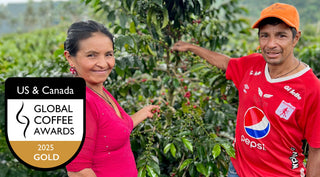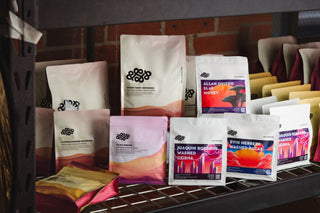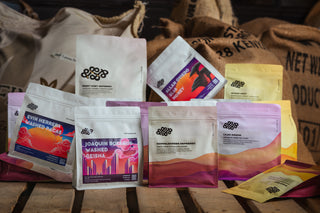Over the past few years, you may have noticed a Costa Rican coffee called “Manuel Arce” on our menu. We have been working with Manuel “Macho” Arce for the past three harvests. Macho is a committed coffee producer from the Llano Bonito de Naranjo sub region of the West Valley of Costa Rica. Macho does not process his coffee at his farm, instead he has partnered with the famous Helsar de Zarcero mill. Helsar works with a select number of coffee producers in the area and is known for producing some of the best quality in Costa Rica. We also have been working for the past three harvests with Helsar, specifically Ricardo Perez, who is one of the owners.
During last year’s harvest, we began discussing with Macho and Ricardo, the possibility of launching a program aimed at making some changes to the mentality with which the coffee is picked. In order to achieve this, we needed to tackle some big issues:
1) How do we re-train the pickers, who have been picking the same way for generations?
2) How do we create a financial incentive for the pickers to change the way they pick? How do we ensure that this incentive is sustainable for us and for our customers?
3) How do we follow up to ensure that the new picking paradigm results in better picked coffee?
I spent the past few months speaking with Ricardo and Macho about how to tackle these issues and we came up with a plan that addressed each of them.
The Picking and The Price
It’s worth noting that Macho Arce (along with other quality focused producers in Costa Rica) have historically done a “good” job with their picking. Good in the sense that the coffee picked consists of mostly properly ripe cherry, with some under-ripe and minimal green or over-ripe cherry. With a farm like Macho’s and the processing at Helsar, this type of picking produces very good to excellent coffee. Presently, I feel like there is a good deal of “very good” coffee in Costa Rica, but what we are trying to see with Macho is if we can get “absolutely outstanding” coffee from his farm by greatly improving his picking.

Example of “good” picking
The process for compensating pickers is simple: they are paid by volume. The country’s unit of measure for paying the picker is a “cajuela” derived from the word “caja” meaning box. The basket that the pickers use to hold the cherries while picking is approximately one cajuela (which is approximately 12.5kg of coffee cherry). The Costa Rican Coffee Institute, Icafe, sets the floor cajuela price for the harvest and then it is up to the individual producer to determine what he will pay his pickers (i.e. floor price or more). Typically, good producers who demand better picking pay 20-40% above the floor price.
This year, the floor price per cajuela is 840 Colones, or USD$1.67 per lb of coffee cherries. This, converted to an exportable product, equates to USD$0.37 per lb of green coffee. Macho, along with other quality focused producers in Costa Rica, is paying between 1000-1200 Colones per cajuela.
So, during my visit to Costa Rica this past week, I sat down with Macho and asked him how much we should pay per cajuela to incentivize and compensate the pickers for their extra effort. We decided that, in order to pick to the level of detail we are requesting, a picker would pick half as much per day. So, after much deliberation, we decided to set a price of 2000 Colones per cajuela (2.4 times the floor price). This number would ensure that the pickers feel well compensated in the short term (i.e. daily/weekly) but more importantly, it would ensure that they earn roughly double for the entire harvest. The only implication to this arrangement is that the picker would need to spend more time at Macho’s farm (often there are breaks in the harvest and pickers migrate temporarily to neighbouring farms). This scenario is win-win for everyone since the picker largely prefers to spend all of his/her time at one farm and Macho will need them to do so in order to harvest his coffee using this new model.
Training the Pickers
One of my goals during my visit last week was to spend time with the pickers and explain the motivation for doing this (i.e. so the coffee tastes better). When speaking to pickers, I have always found it difficult for them to relate to our plea of trying to improve coffee. We live in two completely different worlds. To them, going to a cafe and getting a cappuccino is a luxury and a social indulgence that would never cross their minds. So, how do we convey our sincere interest in seeing the coffee reach its potential? This was the challenge and I think we succeeded.

Showing Ripe Cherry
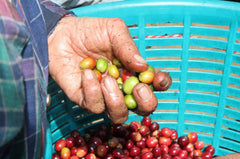
Showing under ripe
Recently I had come to a surprising realization – that it is extremely rare for a coffee picker to have ever tasted a coffee cherry. They are told to pick by colour, and they aim to pick high volume. Tasting their product is not something that tempts them. It is my regular practice at all farms to pick cherry off the coffee tree and taste the fruit. Ripe coffee cherry (outside of exotic varieties) tastes “sweet” with varying degrees of fruity and floral notes, but one thing that everyone who tastes a ripe coffee cherry says is that it tastes sweet. Partially ripe coffee cherry tastes somewhat sweet also, but the sweetness is accompanied by astringency and sometimes a grassy flavour. When I have asked people to compare the taste of a ripe cherry with that of a partially ripe cherry, the response is ubiquitously: “way sweeter”. So, this was going to be the way to the pickers’ hearts: taste tests.
So, when I met with the pickers at Macho’s farm last week, I spoke about the project, our objectives and the compensation model, all of which seemed interesting to them (especially the price of 2000 colones). When we began discussing “how”, I turned to the taste tests. I grabbed some cherries from nearby trees and asked for a volunteer who would taste the perfectly ripe cherry and the partially ripe cherry. Right away, hands went up and I had my first volunteer. I asked him to taste the partially ripe cherry and describe it, which he quickly did, responding, “It’s sweet”. Then I asked him to taste the perfectly ripe cherry and upon tasting it, his eyes lit up and he said, “Wow, it’s so sweet!”. One by one, they all had the same experience. It was a very rare and magical moment in which I felt that, for the first time in my career, I had connected with the pickers. I went on to explain that the sweetness that they tasted in the cherry is what we are looking for in the cup (when we cup it) and this is why we are being so darn picky. At the end of the workshop, there seemed to be a real sense of excitement around them and a sense of pride for the project. Macho, a man of few words himself, was very chatty and excited. He later commented that he felt the pickers really responded and are very engaged – let’s hope.
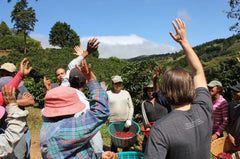
Who’s in?
Is the Model Scalable and Sustainable?
The main objective of this project is to see the extent of the impact that extremely good picking has on cup quality. If we see that the cup quality vastly increases, then we can claim that we found a way to greatly improve the product, thus allowing us to justifiably pass on the cost to the end consumer. If we find a marginal improvement, then the jury is out on whether the added cost and effort is worth it. Time will tell.
Another piece of the puzzle we are hoping to understand via this project is the feasibility for the pickers to execute this precise picking day in and day out. We need to understand whether they will be willing to truly change and embrace this new picking model as their new way of work.
Assuming that pickers can adapt, this picking model should be very scalable and could pave the way for connecting buyers directly (with the assistance of the producer) with the pickers, thus extending the relationship buying model one step further. But at the end of the day, this will only scale if we see results in the cup.
Could every coffee be picked and compensated this way? Unfortunately not; some coffee could be picked exceptionally well but it will never produce a great cup. This is due to a combination of factors such as the coffee plant variety, soil, micro-climate, plant tissue age and plant nutrition. Macho’s farm is a great place to launch this project because he has a truly amazing farm capable of producing great quality and he himself is a motivated farmer keenly interested in learning and improving quality.
Making Sure It Happens
This is perhaps the trickiest bit of the equation. My visit was successful and inspiring, but without a process and proper follow through, this project will likely fail. So, how do we prevent this from failing?
First, we decided that the pickers should choose whether they want to participate in the program or not. So, those who feel they want the challenge and the possibility of earning more will submit picked coffee to Macho for his approval. Every basket will be inspected and approved or rejected by Macho. If it is rejected, the picker will have the option of submitting to the “normally picked” coffee pile or manually sort the partially ripe cherry and resubmit for inspection. At the end of each picking day, Macho will deliver two lots of coffee to Helsar: the Cajuela Project lot and the traditional lot. Helsar will perform a second inspection upon receiving the coffee. Helsar will perform special processing to the Cajuela Project lot and will keep it separate from the rest. I will be back in Costa Rica in February to cup all the Cajuela Project lots and evaluate the progress.
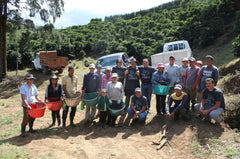
Macho, Ricardo, Francisco, Sebastian & the pickers
Processing at Helsar
I wish I could say that all one has to do to produce exceptional coffee is pick it at the optimum level of ripeness, but sadly this is simply not the case. In order to capitalize on the great picking, the coffee must be carefully washed and dried. This is where Helsar comes in. As I mentioned, Helsar is known as one of the best coffee processors in Costa Rica, but being the mensch that he is, Ricardo wanted to use this project to tackle some areas in processing he felt needed improvement: the fully washed process and the drying process. As part of the Viva La Cajuela project, Helsar is implementing new processes for the coffee, which I will describe in more detail on a later post.

Macho and Sebastian at the farm
The T-Shirts
As part of the launch of this project, we made T-shirts (thank you Pierre and Candace of Food on your Shirt) with the intent of giving the shirts to the pickers during my visit. I handed out t-shirts to all the pickers, Macho, his family and the Helsar crew and they were a huge hit. If you would like to purchase a t-shirt, click here. All proceeds will go towards the purchase of a Brix meter for Macho and some gifts for the pickers. He will be able to use the Brix meter to measure the sugar content on the coffee cherries and learn about optimal picking.
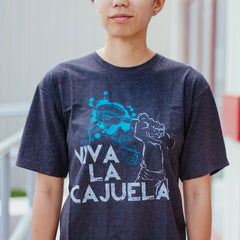

Viva La Cajuela Tee
One final comment, Francisco Mena from Exclusive Coffee has been instrumental in launching this program. His passion, enthusiasm and drive are inspiring and essential for this kind of development to actually happen.
– Sebastian

